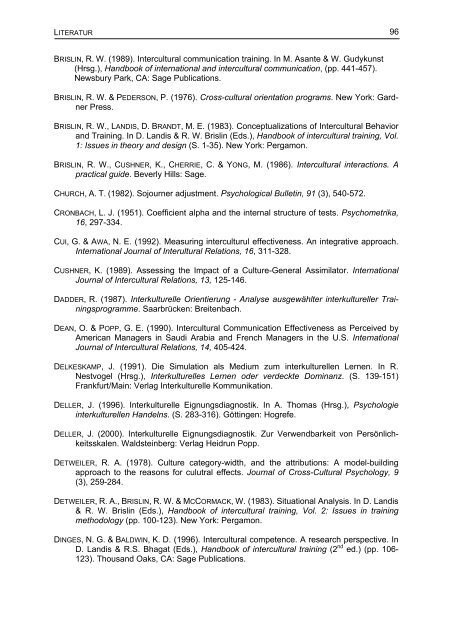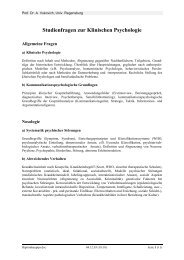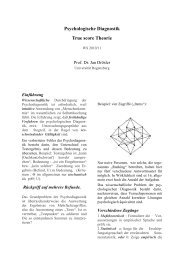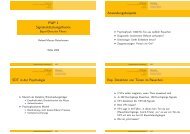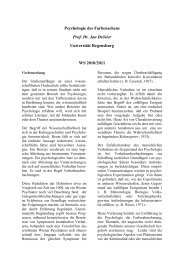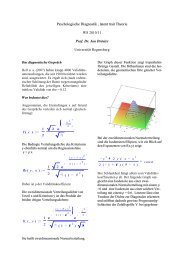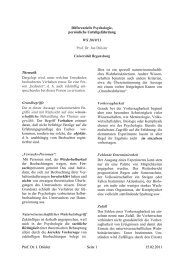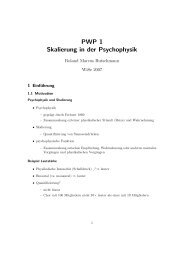Entwicklung eines Tests zur Erfassung interkultureller ...
Entwicklung eines Tests zur Erfassung interkultureller ...
Entwicklung eines Tests zur Erfassung interkultureller ...
Sie wollen auch ein ePaper? Erhöhen Sie die Reichweite Ihrer Titel.
YUMPU macht aus Druck-PDFs automatisch weboptimierte ePaper, die Google liebt.
LITERATUR 96<br />
BRISLIN, R. W. (1989). Intercultural communication training. In M. Asante & W. Gudykunst<br />
(Hrsg.), Handbook of international and intercultural communication, (pp. 441-457).<br />
Newsbury Park, CA: Sage Publications.<br />
BRISLIN, R. W. & PEDERSON, P. (1976). Cross-cultural orientation programs. New York: Gardner<br />
Press.<br />
BRISLIN, R. W., LANDIS, D. BRANDT, M. E. (1983). Conceptualizations of Intercultural Behavior<br />
and Training. In D. Landis & R. W. Brislin (Eds.), Handbook of intercultural training, Vol.<br />
1: Issues in theory and design (S. 1-35). New York: Pergamon.<br />
BRISLIN, R. W., CUSHNER, K., CHERRIE, C. & YONG, M. (1986). Intercultural interactions. A<br />
practical guide. Beverly Hills: Sage.<br />
CHURCH, A. T. (1982). Sojourner adjustment. Psychological Bulletin, 91 (3), 540-572.<br />
CRONBACH, L. J. (1951). Coefficient alpha and the internal structure of tests. Psychometrika,<br />
16, 297-334.<br />
CUI, G. & AWA, N. E. (1992). Measuring interculturul effectiveness. An integrative approach.<br />
International Journal of Interultural Relations, 16, 311-328.<br />
CUSHNER, K. (1989). Assessing the Impact of a Culture-General Assimilator. International<br />
Journal of Intercultural Relations, 13, 125-146.<br />
DADDER, R. (1987). Interkulturelle Orientierung - Analyse ausgewählter <strong>interkultureller</strong> Trainingsprogramme.<br />
Saarbrücken: Breitenbach.<br />
DEAN, O. & POPP, G. E. (1990). Intercultural Communication Effectiveness as Perceived by<br />
American Managers in Saudi Arabia and French Managers in the U.S. International<br />
Journal of Intercultural Relations, 14, 405-424.<br />
DELKESKAMP, J. (1991). Die Simulation als Medium zum interkulturellen Lernen. In R.<br />
Nestvogel (Hrsg.), Interkulturelles Lernen oder verdeckte Dominanz. (S. 139-151)<br />
Frankfurt/Main: Verlag Interkulturelle Kommunikation.<br />
DELLER, J. (1996). Interkulturelle Eignungsdiagnostik. In A. Thomas (Hrsg.), Psychologie<br />
interkulturellen Handelns. (S. 283-316). Göttingen: Hogrefe.<br />
DELLER, J. (2000). Interkulturelle Eignungsdiagnostik. Zur Verwendbarkeit von Persönlichkeitsskalen.<br />
Waldsteinberg: Verlag Heidrun Popp.<br />
DETWEILER, R. A. (1978). Culture category-width, and the attributions: A model-building<br />
approach to the reasons for culutral effects. Journal of Cross-Cultural Psychology, 9<br />
(3), 259-284.<br />
DETWEILER, R. A., BRISLIN, R. W. & MCCORMACK, W. (1983). Situational Analysis. In D. Landis<br />
& R. W. Brislin (Eds.), Handbook of intercultural training, Vol. 2: Issues in training<br />
methodology (pp. 100-123). New York: Pergamon.<br />
DINGES, N. G. & BALDWIN, K. D. (1996). Intercultural competence. A research perspective. In<br />
D. Landis & R.S. Bhagat (Eds.), Handbook of intercultural training (2 nd ed.) (pp. 106-<br />
123). Thousand Oaks, CA: Sage Publications.


